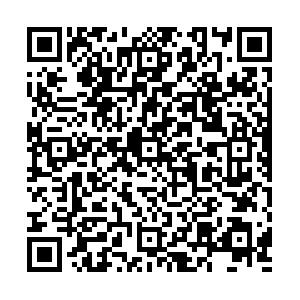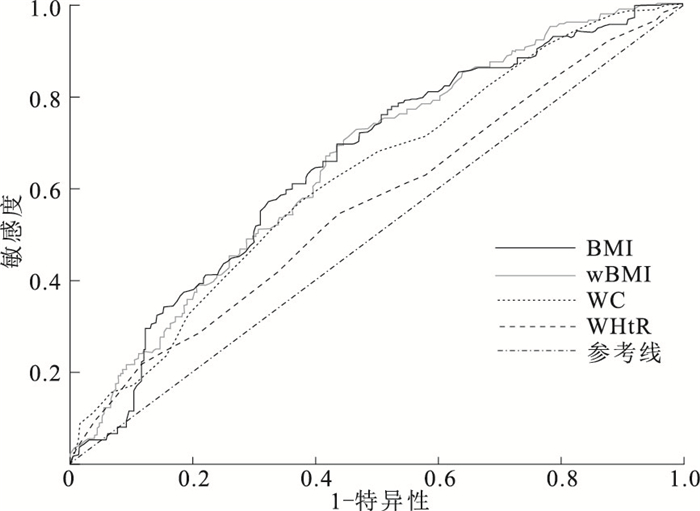Analysis of ROC curves for the effect of predicting hand grip strength based on morphological indicators in high school girls
-
摘要:
目的 评估并比较高中女生体质量指数(BMI)、腰围(WC)、胸围体质量指数(wBMI)及腰高比(WHtR)对握力(HGS)预测的准确性,为评估高中女生整体身体素质及健康状况提供参考。 方法 2022年5—12月,采用整群随机抽样方法从江苏省徐州市12所高中选取1 600名15~18岁女生为研究对象,测量HGS、WC、身高及体重等,并进一步计算BMI、wBMI及WHtR。采用Pearson相关和Logistic回归分析BMI、wBMI、WC及WHtR与HGS的关联。构建受试者工作特征(ROC)曲线,评估不同指标预测HGS的准确性。 结果 Pearson相关分析结果显示,高中女生BMI、WC、wBMI及WHtR与HGS均呈正相关(r值分别为0.31,0.27,0.32,0.14,P值均 < 0.01)。Logistic回归分析表明,高中女生的BMI、WC及wBMI与HGS均相关(OR值分别为2.00,0.47,1.22,P值均 < 0.05),而WHtR与HGS的相关性无统计学意义(OR=0.51,P>0.05)。高中女生BMI预测HGS的曲线下面积(AUC)最大(AUC=0.65,95%CI=0.61~0.69),其次是wBMI预测HGS的曲线下面积(AUC=0.65,95%CI=0.57~0.66)(P值均 < 0.05);敏感度最大的是wBMI(71.5%),其次是BMI(69.4%),敏感度最小的是WHtR(52.3%);WC的特异性最好(61.1%),wBMI的特异性相对较低(52.5%)。 结论 高中女生的BMI、WC和wBMI能够预测HGS强弱,其中BMI和wBMI的准确性和敏感度最大,但wBMI预测HGS强弱的特异性最低。 Abstract:Objective To evaluate and compare the accuracy of body mass index (BMI), waist circumference (WC), waistcorrected BMI (wBMI), and waist-to-height ratio (WHtR) in predicting hand grip strength (HGS) in high school girls, so as to provide the reference for evaluating their overall physical fitness and health status. Methods From May to December in 2022, a total of 1 600 girls aged 15 to 18 years old were selected by cluster random sampling from 12 high schools in Xuzhou, Jiangsu Province. Measures of HGS, waist circumference, height and weight among high school girls were taken, and their BMI, wBMI and WHtR were calculated. Pearson correlation analysis and Logistic regression were used to analyze the association between BMI, wBMI, WC, WHtR and HGS Receiver operating characteristic (ROC) curves were constructed to evaluate the accuracy of different indicators in predicting HGS Results Pearson correlation analysis showed that the BMI, wBMI, WHtR and HGS expression of high school girls were positively correlated (r=0.31, 0.27, 0.32, 0.14, P < 0.01). Logistic regression analysis showed that BMI, WC and wBMI were correlated with HGS expression (OR=2.00, 0.47, 1.22, P < 0.05), while the association of WHtR and HGS expression had no statistical significance (OR=0.51, P>0.05). The area under the curve (AUC) of BMI for predicting HGS expression in high school girls was the largest (AUC=0.65, 95%CI=0.61-0.69), followed by the AUC of wBMI for predicting HGS expression (AUC=0.65, 95%CI=0.57-0.66)(P < 0.05). The most sensitivity was wBMI (71.5%), followed by BMI (69.4%), and the least sensitivity was WHtR (52.3%); and WC had the best specificity (61.1%), whereas wBMI had a relatively low specificity (52.5%). Conclusion For high school girls, BMI, WC and wBMI could predict the strenth of HGS expression, but BMI and wBMI have the highest accuracy and sensitivity, while wBMI has the lowest specificity in predicting the strenth of HGS. -
Key words:
- Body weights and measures /
- Hand strength /
- ROC curve /
- Regression analysis /
- Students /
- Female
1) 利益冲突声明 所有作者声明无利益冲突。 -
表 1 不同握力组高中女生的身体形态指标比较(x±s)
Table 1. Comparison of different body shape indexes of high school girls in different HGS groups (x±s)
组别 人数 身高/cm 体重/kg BMI/(kg·m-2) wBMI/(kg·m-1) WC/cm WHtR HGS/kg 高HGS组 728 164.42±5.25 59.02±7.68 21.85±2.71 16.09±3.40 73.28±7.46 0.57±0.04 28.89±2.72 低HGS组 872 163.39±4.82 54.57±7.54 20.44±2.68 14.40±3.07 69.92±6.72 0.56±0.04 21.93±2.40 t值 2.52 7.15 6.34 6.64 5.79 3.29 33.22 P值 0.01 < 0.01 < 0.01 < 0.01 < 0.01 < 0.01 < 0.01 -
[1] SHETTY M, BALASUNDARAN S, MULLERPATAN R. Grip and pi-nch strength: reference values for children and adolescents from India[J]. J Pediatr Rehabil Med, 2019, 12(3): 255-262. [2] OMAR M T A, ALGHADIR A H, ZAFAR H, et al. Hand grip st-rength and dexterity function in children aged 6-12 years: a cross-sectional study[J]. J Hand Ther, 2018, 31(1): 93-101. doi: 10.1016/j.jht.2017.02.004 [3] ALQAHTANI B A, ALENAZI A M, ELNAGGAR R K, et al. Normative values for hand grip and pinch strength for 6 to 18 year-olds in Saudi Arabia[J]. BMC Musculoskelet Disord, 2023, 24(1): 96. doi: 10.1186/s12891-023-06197-0 [4] KIM J. Handgrip strength to predict the risk of all-cause and premature mortality in Korean adults: a 10-year cohort study[J]. Int J Environ Res Public Health, 2021, 19(1): 39. doi: 10.3390/ijerph19010039 [5] CONCHA-CISTERNAS Y, PETERMANN-ROCHA F, CASTRO-PIÑERO J, et al. Handgrip strength as a predictor of adverse health outcomes[J]. Rev Med Chil, 2022, 150(8): 1075-1086. doi: 10.4067/S0034-98872022000801075 [6] LAITINEN T T, SANER C, NUOTIO J, et al. Lower grip strength in youth with obesity identifies those with increased cardiometabolic risk[J]. Obes Res Clin Pract, 2020, 14(3): 286-289. doi: 10.1016/j.orcp.2020.04.004 [7] SCHRÖDER G, HOTH I, FLACHSMEYER D, et al. Evaluation of bone density and hand grip strength in the course of drug treatment for osteoporosis: a real-world study[J]. Orthopadie (Heidelb), 2023, 52(12): 992-1004. [8] KAKARAPARTHI L, GADHAVI B, KAKARAPARTHI V N, et al. Handgrip strength and its correlation with anthropometric determinants and hand dimensions in children aged 6-12 years: a cross-sectional study[J]. Work, 2023, 74(2): 711-721. doi: 10.3233/WOR-211368 [9] XU T, LI X, WANG D, et al. Hand grip strength should be normalized by weight not height for eliminating the influence of individual differences: findings from a cross-sectional study of 1 511 healthy undergraduates[J]. Front Nutr, 2023, 9: 1063939. doi: 10.3389/fnut.2022.1063939 [10] TSEKOURA M, BAKIRTZI S, PAPADIMITROPOULOU S, et al. Relationship of hand grip strength, physical activity, and anthropometric characteristics in a sample of male and female physiotherapy students[J]. Adv Exp Med Biol, 2023, 1425: 491-500. [11] AGTUAHENE M A, QUARTEY J, KWAKYE S. Influence of hand dominance, gender, and body mass index on hand grip strength[J]. S Afr J Physiother, 2023, 79(1): 1923. [12] ANTONINI-CANTERIN F, DI NORA C, POLI S, et al. Obesity, cardiac remodeling, and metabolic profile: validation of a new simple index beyond body mass index[J]. J Cardiovasc Echogr, 2018, 28(1): 18-25. doi: 10.4103/jcecho.jcecho_63_17 [13] MOLTRER M, PALA L, COSENTINO C, et al. Body mass index (BMI), waist circumference (WC), waist-to-height ratio (WHtR) e waist body mass index (wBMI): which is better[J]. Endocrine, 2022, 76(3): 578-583. doi: 10.1007/s12020-022-03030-x [14] ELBEDEWY R M S, EL SAID S M S, TAHA R M. Indicators of abnormal hand grip strength among older egyptian adults[J]. J Multidiscip Healthc, 2020, 13: 387-392. [15] 张艺宏, 徐峻华, 何本祥, 等. 运动机能评定理论与方法[M]. 北京: 科技出版社, 2018.ZHANG Y H, XU J H, HE B X, et al. Motor function evaluation theory and method[M]. Beijing: Science and Technology Press, 2018. (in Chinese) [16] ALQAHTANI B, ALENAZI A, ALSHEHRI M, et al. Reference values and associated factors of hand grip strength in elderly Saudi population: a cross-sectional study[J]. BMC Geriatr, 2019, 19(1): 271. doi: 10.1186/s12877-019-1288-7 [17] ALAHMARI K A, SILVIAN S P, REDDY R S, et al. Hand grip strength determination for healthy males in Saudi Arabia: a study of the relationship with age, body mass index, hand length and forearm circumference using a hand-held dynamometer[J]. J Int Med Res, 2017, 45(2): 540-548. doi: 10.1177/0300060516688976 [18] LIM S H, KIM Y H, LEE J S. Normative data on grip strength in a population-based study with adjusting confounding factors: sixth Korea national health and nutrition examination Survey (2014-2015)[J]. Int J Environ Res Public Health, 2019, 16(12): 2235. doi: 10.3390/ijerph16122235 [19] YANG P, TANG J, SHU Y, et al. Using quantitative computed tomography to study the correlation between physical composition and grip strength in young people[J]. J Sichuan Univ (Med Sci), 2022, 53(6): 1081-1089. [20] CHON D, SHIN J, KIM J H. Consideration of body mass index (BMI) in the association between hand grip strength and hypertension: Korean longitudinal study of ageing (KLoSA)[J]. PLoS One, 2020, 15(10): e0241360. doi: 10.1371/journal.pone.0241360 [21] GARCIA-HERMOSO A, TORDECILLA-SANDERS A, CORREA-BAUTISTa J E, et al. Handgrip strength attenuates the adverse effects of overweight on cardiometabolic risk factors among collegiate students but not in individuals with higher fat levels[J]. Sci Rep, 2019, 9(1): 6986. doi: 10.1038/s41598-019-43471-5 [22] MANZANO-CARRASCO S, GARCIA-UNANUE J, HAAPALA E A, et al. Relationships of BMI, muscle-to-fat ratio, and handgrip strength-to-BMI ratio to physical fitness in Spanish children and adolescents[J]. Eur J Pediatr, 2023, 182(5): 2345-2357. doi: 10.1007/s00431-023-04887-4 [23] ASIRI F, DIXIT S, ALSUBAIE S F, et al. Comparison of neck circumference, waist circumference, and skinfold thickness in measuring the subcutaneous fat distribution and their association with handgrip strength: cross-sectional study[J]. Int J Environ Res Public Health, 2022, 19(21): 14283. doi: 10.3390/ijerph192114283 [24] KOBAYASHI G, SHINOZAKI T, OKADA H, et al. Associations between anthropometric indices as complementary predictors and incidence of type 2 diabetes; Panasonic Cohort Study 21[J]. Diabetes Res Clin Pract, 2024, 217: 111888. doi: 10.1016/j.diabres.2024.111888 [25] WANG N, LI Y, GUO C. Waist-corrected BMI predicts incident diabetes mellitus in a population-based observational cohort study[J]. Front Endocrinol (Lausanne), 2023, 14: 1186702. doi: 10.3389/fendo.2023.1186702 -







 下载:
下载:

